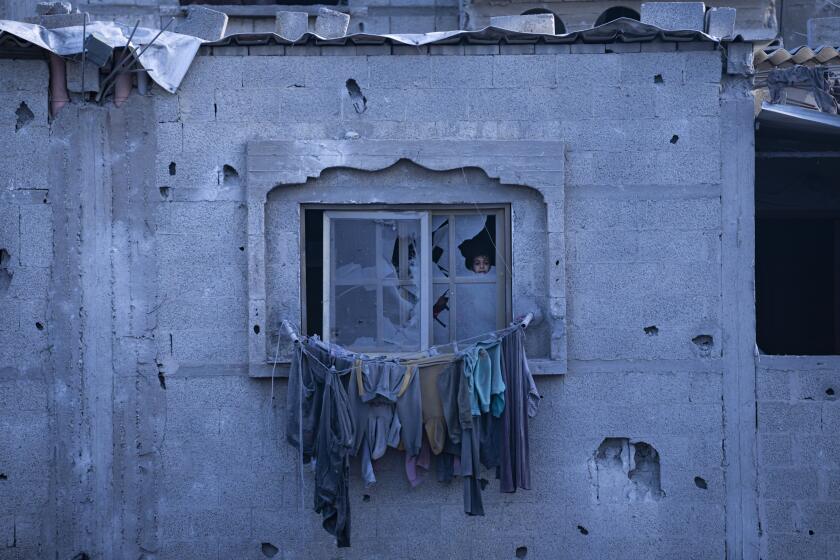Small Missouri Town Pulls Out All the Stops in Battle With the River : Disaster: Residents of St. Genevieve, Mo., are used to high water, but the current crisis has turned their community into a ‘civilian war zone.’
Bob Gegg, deeply tanned and unlit cigar in his mouth, slammed the earthmover into gear and began to push the next load of limestone chunks uphill and into place on the levee.
He had been doing this all Wednesday morning, going back and forth, back and forth, to the spot on Main Street where the huge dump trucks stopped and deposited their loads.
He had, in fact, been doing the same thing for days on end as this small farming town struggles to save itself from the onrushing Mississippi River.
“I’ve been working so long my dog growled at me when I went home last night,” said Gegg as he sipped from a bottle of Gatorade. “He didn’t know who I was.”
St. Genevieve, 65 miles to the south of St. Louis, is normally about two miles from the Mississippi ferry crossing. Now, the river is at its doorstep.
Where once Main Street led out of town past the airport to the ferry crossing, a huge mound of earth 46 feet high is keeping the water back. Some have taken to calling it their Great Wall of China.
To stand on the top of the levee at Main Street is to see nothing but water, half-submerged trees and a lonely wind sock a few feet above the water line where the airport used to be. The growl of machines hauling rock and pumping water and pushing the levee walls ever higher fills the air.
In the parking lot of the St. Genevieve Parish Center, dozens of townspeople, along with National Guard troops and inmates from the state prison in nearby Farmington, Mo., work around the clock filling sandbags.
There is no stopping, very little rest, great optimism and great fear. The old levee that kept out all but the worst floods has been bolstered by at least 500,000 sandbags and close to 80,000 tons of rock. The most common vehicle in town is a dump truck.
“It’s the best example I’ve ever seen of a civilian war zone,” Mayor Bill Anderson said Wednesday morning.
And finding out who has won the battle won’t happen for days, or even weeks. While the river has already crested well to the north, it will not happen in St. Genevieve until Sunday at the earliest. And there is still the question of how much more rain will continue to fall upstream.
The river here has already displaced about 170 families whose homes were beyond the levee. And there have been some close calls.
Gegg, the heavy-equipment operator, said his worst day was Sunday. When he arrived in the morning at a spot along the levee he was supposed to build up, he looked over the side and saw the river only four inches from the top.
“I was given a life preserver to wear,” he said.
Lawrence Samples, a local mechanic, was walking along one section of the levee Wednesday morning when he pointed to a spot where rocks and sandbags were holding back the water.
“On Sunday they found it was getting all soggy, and the water was about to break through. We had to get sandbags up there quick or this whole neighborhood would have been under water,” he said.
A few minutes later, a truckload of prisoners, all tattoos and iron-pumped muscle, drove by on their way to another assignment.
“Those guys can flat work,” Samples said. “I’ve never seen anything like it.”
This town of historic old homes is no stranger to flooding.
But this flood was more crafty, coming unexpectedly in the summer.
Ken Kulberg, who moved here with his wife from Chicago two years ago to restore an old building and open a bed-and-breakfast, said it took a while for the realization to sink in that St. Genevieve was in for a major fight.
“I didn’t expect the worst,” he said as he helped unload gravel and stone only half a block from his Main Street Inn. “We had been through a flood in the spring and I thought we were high and dry. I assumed we had been through a flood and that it would go away. But of course, it didn’t.”
Most of the bottom floor of the inn is now empty, on the chance that the river will win after all.
But over at the Southern Hotel, just down the street, there was a note of optimism. Never mind that the water of the Mississippi was a stone’s throw away. The owners had strung out a banner on the front porch. It said: “Ste. Genevieve. Doing It Again. Beating Ole Man River.”
A Homeowner’s Nightmare
Flooding damages houses from above ground, with rising water levels, and below ground, as floodwater seeps through a home’s concrete foundations.
The Danger Above
1) Pressure on exterior walls triples from 20 pounds per square foot to 62 pounds per square foot, weakening the 2-by-4s that are the main support for the walls.
2) High water ruins interior walls, insulation and wiring.
3) Floodwater’s current can push a home off its concrete base.
4) Waves generated by storms can pound the home, further weakening the structure.
*
The Danger Below
A) Floodwater puts four times the amount of pressure on a basement wall, causing cracks.
B) Water pours through cracks, weakening the foundation and filling the basement.
C) Water weakens the anchors that secure the house to a concrete foundation.
*
Eight-Inch Concrete at Risk
The pressure of a typical load on a basement wall, eight-feet deep with eight-inch concrete or concrete masonry walls, is roughly 30 pounds per cubic foot. But when exposed to flooding, the pressure of seeping water can increase to as much as 120 pounds per cubic foot.
Sources: Eric Horlyk, Advanced Engineering Inc., West Des Moines, Iowa; Times staff
More to Read
Sign up for Essential California
The most important California stories and recommendations in your inbox every morning.
You may occasionally receive promotional content from the Los Angeles Times.










